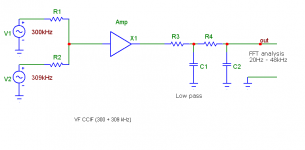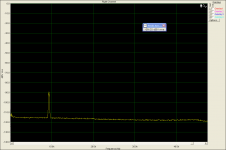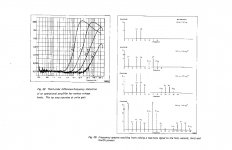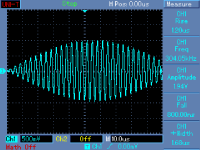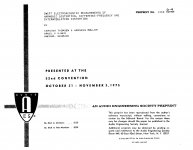If 19+20kHz max. dv/dt is considered slow, why not to test at higher frequencies, same method?? My usual test is HF CCIF at 300 + 309kHz. Schematic of the method attached. The test frequencies have to be high, but not much above Fc of the input RC filter.
Attachments
Last edited:
Okay John I follow you on this. You answered my question in that you would have to go above the 30khz point in order to stay out of the audio band and still remain flat up to 20Khz. I know that I have to study more about the differences between slew rate and settling time. Thanks for the answers and I am glad that we didn't have any flame wars on this subject. I didn't see the response for some reason earlier or I would have responded earlier to the thread.
Like this?
I do not know, I cannot read the tone frequencies. Like this:
Attachments
Try my square wave two speed trick- you'll be surprised. I'll try to dig up and post some scope photos to illustrate this point.
I've tried my 1/3 octave noise test at two speeds too, the stylus can't track the recording even when it stays in the groove. So remind me why this thread has circled again back 35 yr. to talk about why 741's are not good for audio.
So remind me why this thread has circled again back 35 yr. to talk about why 741's are not good for audio.
Jethro Tull - Living in the past - YouTube
PMA, I put up one page of a paper written by B&K in the early '70's. It is a fairly complete paper on TWO TONE DISTORTION, and I thought that you should become aware of it.
In all fairness, most midfi equipment is made with a modified 741 type topology, even today, so while slightly improved, the new devices suffer from much the same distortion generating mechanisms as earlier devices.
In all fairness, most midfi equipment is made with a modified 741 type topology, even today, so while slightly improved, the new devices suffer from much the same distortion generating mechanisms as earlier devices.
Last edited:
Here is the article. Unfortunately, it is too long to put up here. Perhaps, PMA, you should get the article, since it is about 2 tone testing, and you are doing that too.
One problem here is that while the questions by others are intelligent, they have already been answered and worked through, long ago. It is like teaching a class, where the students don't know much about the material, rather than discussions among professionals.
One problem here is that while the questions by others are intelligent, they have already been answered and worked through, long ago. It is like teaching a class, where the students don't know much about the material, rather than discussions among professionals.
Attachments
Last edited:
...it suffers from much the same distortion generating mechanisms as earlier devices.
That's the opposite of what you claimed when citing the all-important Quan test.
It is like teaching a class, where the students don't know much about the material, rather than discussions among professionals.
We'll all keep staring at the ground and drooling.
In all fairness, most midfi equipment is made with a modified 741 type topology, even today, so while slightly improved, the new devices suffer from much the same distortion generating mechanisms as earlier devices.
In all fairness, I am not much interested in uA741 or its slightly improved versions.
What is quite interesting is the fact, that the AD797, with no extraordinary slew rate 20V/us, performs in a 19 + 20 kHz test much better than many (or most of) devices with slew rate > 50V/us. It also performs better in a 30kHz THD test. So, it is not only about slew rate. Of course, it will not handle well 5MHz full scale signal. But, as you are saying, we should argue reasonably. 5V/us is definitely not enough and 1000V/us is definitely not necessary.
A teacher who keeps telling his class that they are thick and lazy, while refusing to explain the subject matter to them but offering anecdotes instead of derivations, should not be surprised if the naughty but bright kids at the back of the class start drooling and making paper aeroplanes.
What is quite interesting is the fact, that the AD797, with no extraordinary slew rate 20V/us, performs in a 19 + 20 kHz test much better than many (or most of) devices with slew rate > 50V/us. It also performs better in a 30kHz THD test.
But you're ignoring the invisible 7th harmonic that we've been assured is what separates mid-fi junk like the 797 from fine high-end designs.
In all fairness, I am not much interested in uA741 or its slightly improved versions.
What is quite interesting is the fact, that the AD797, with no extraordinary slew rate 20V/us, performs in a 19 + 20 kHz test much better than many (or most of) devices with slew rate > 50V/us.
VERY low open-loop BW and LOTS of feedback.
This reminds me of the incident in the movie: 'Legally Blonde', where the student comes to a law class at Harvard University and is asked to leave, BECAUSE she did not read the assignment in advance. And I just ask that many here read the material offered, before asking me questions about the subject. Is it too much to ask? '-)
But you're ignoring the invisible 7th harmonic that we've been assured is what separates mid-fi junk like the 797 from fine high-end designs.
Oh I am sorry. You mean designs like this one:
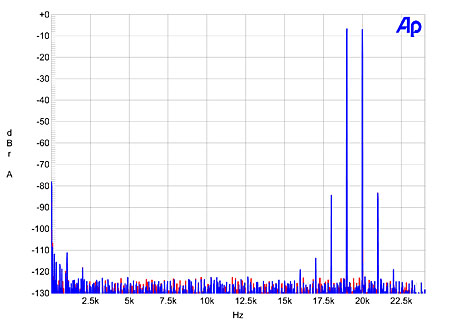
Parasound Halo JC 2 line preamplifier Measurements | Stereophile.com
If you look at the image, what is the line at 16kHz? Isn't it the 7th?
When you can get 7th harmonic from an all Class A, all FET, balanced complementary differential design, you have a mystery.
No mystery at all (most of the things you cite go to even order harmonics). Why not take credit for doing it right and avoiding the issue?
- Status
- Not open for further replies.
- Home
- Member Areas
- The Lounge
- John Curl's Blowtorch preamplifier part II
